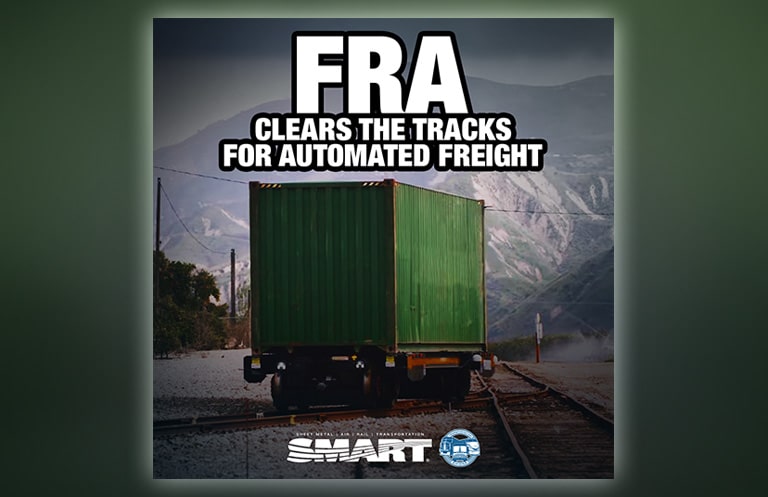
The Federal Railroad Administration (FRA) has granted 22 waivers to Genesee and Wyoming Railroad subsidiaries, including the Heart Of Georgia Railroad (HOG) and Georgia Central Railway, to begin testing autonomous freight rail cars. These waivers will allow the companies to move forward with seven stages of testing on prototypes developed by Parallel Systems.
While supporters of this technology hail it as the future of rail transportation, SMART-TD has made our stance clear to the FRA about the potential dangers these autonomous vehicles pose to our members, the public, and the rail industry as a whole.
SMART-TD Raises Alarm Over Safety Risks
Union representatives have been attending demonstrations of Parallel Systems’ self-driving rail vehicles for years, and their findings have been alarming. These vehicles, which the manufacturer insists are “not rail cars,” consistently fall short of the basic safety standards necessary to protect both rail workers and the communities they serve. The prototypes have failed several critical safety tests, leading to mounting concerns.
One of the most significant safety flaws observed during testing was the vehicles’ failure to adequately warn oncoming traffic at road crossings. The horns and bells on these autonomous vehicles have been found to be insufficiently loud, creating a dangerous situation for workers, drivers, and pedestrians.
Somebody Please RedBlock The Robot
In one demonstration, a self-driving rail vehicle ran through a misaligned switch, highlighting a serious flaw in the technology that could lead to catastrophic accidents. Even with no crew onboard, the potential consequences are severe; whatever the vehicle might hit could endanger the lives of rail workers, especially SMART-TD members who may be operating nearby equipment. This reality is simply unacceptable.
Perhaps most concerning are the vehicles’ braking performance and stopping distances. Even at low speeds, these autonomous vehicles require unreasonably long distances to come to a stop. In a test involving a single stack intermodal car, the prototype failed to meet basic stopping standards. This raises serious questions about how the vehicles would respond in emergency situations or navigate challenging track conditions, which is an everyday reality on the rails.
These “not rail cars” are self-powered by large-scale lithium batteries, which means that under current safety regulations they would be classified as hazardous loads even when empty.
Without a crew member in direct control means that there would be no engineer or conductor on hand to share crucial information to first responders, including documentation about the hazardous materials onboard. The risk of sending these dangerous self-driving vehicles into public spaces without proper safeguards is deeply troubling.
Despite these concerns, the FRA has granted each of the 22 safety regulation waivers that were requested. They are allowing testing to proceed. These waivers include exceptions for essential safety features such as grab irons (since there will be no crew aboard), the ability to skip brake tests, and the absence of hand brakes. These are basic components necessary to ensure safe rail operations and the protection of workers.
A Departure From Industry Safety Standards
Don Roach, SMART-TD’s State Safety and Legislative Director in Michigan was present for a Parallel Systems test/demonstration in Pueblo, Colorado, on March 6, 2024. “After reading the FRA’s letter allowing this to go forward, I’m still stuck on FRA saying it is ‘in the public interest and consistent with railroad safety.’ How can they claim it’s consistent with safety when they’re allowing the testing of something with so many unknown risks?”
Brother Roach emphasized his belief that the FRA’s participation in the testing process is supposed to focus on safety. Instead, he feels the FRA’s decision letter worries more about “effectiveness” than it does about fully assessing the risks of this new, untested technology. “I thought the FRA’s mission was about safety, not testing the limits of the capabilities of a self-propelled, zero-emission rail vehicle with known flaws that put every man and woman near the ballast in danger,” he added.
Despite repeated warnings from union representatives, including written public comments submitted to the FRA, the agency granted the 22 waivers.
According to SMART-TD’s National Safety and Legislative Department, this move is part of an ongoing trend to replace human workers with automation technology, putting both human safety and the integrity of the rail system at risk.
SMART-TD will continue to fight to protect its members, uphold safety standards, and ensure that the railroads of tomorrow remain safe, reliable, and operated by skilled professionals committed to putting safety first.
To review the 22 waivers granted for this testing, please visit the following link:
Related News
- SMART’s General President Defends Our Brother
- Maryland Passes Monumental Transit Safety Bill
- Brother Wirth Crowned Champion in 168-Pound Masters Division Victory
- Chairman Pauli Announces Retirement, SMART-TD celebrates his career
- SMART statement on Supreme Court’s decision regarding Kilmar Armando Abrego Garcia’s return to the United States
- SMART-TD Stands With Brother Kilmar Abrego Garcia
- New Mexico Local 1687 sets new precedent with Red Apple Transit
- Tentative Agreement Reached With TransitAmerica Services (TASI)
- SMART issues Monday, April 7, statement on Kilmar Armando Abrego Garcia’s ongoing case
- Local 5 organizes enormous growth in North Carolina